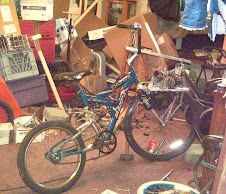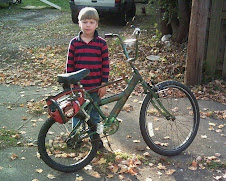I am experimenting with a gas engine again. The experiments are with a weed whacker motor but I will most likely buy a gasoline friction drive kit. I am tired of the battery and trailer thing to be honest. I don't mind the slower speed or the short distances between chargers for the most part but frankly the cost of lightweight batteries and the charging times just make it seem as though for the most part a gas bike is better for me at least.
I know it isn't green but that's life. If you want green, make the batteries cheaper and more efficient. Which is not the same as making gasoline bikes too expensive to ride. That's the socialists idea of improvements. Don't make the new technology cheaper, instead the lefties say make the old technology more expensive through false costs.
Thursday, November 25, 2010
Wednesday, November 17, 2010
Monday, November 15, 2010
Sunday, November 7, 2010
The bike is doing fine with just an on/off switch. I'm running the 24v 600watt Currie motor with a 24v sla and a 6v nimh battery for 30v. I mention the nimh as a separate battery because it makes the power surge different. More mello is the only way I can describe the difference. With Sla when you hit the on switch the bike jump like crazy. With the nimh in the circuit it just eases into the power curve. I know it sounds ridiculous but that is what happens.
Anyway it does fine. On most of the hills here the bike runs fast enough that I can't catch the freewheel. I should put a larger chain ring on the bike so that I can help more, but I just haven't felt the need just yet.
Anyway it does fine. On most of the hills here the bike runs fast enough that I can't catch the freewheel. I should put a larger chain ring on the bike so that I can help more, but I just haven't felt the need just yet.
Wednesday, November 3, 2010
I have been painting the house lately, so I didn't get to ride the bike after the switch back to an on off switch until yesterday. The bike has noticeably more power with the on off switch. It probably is pulling a couple of more amps going uphill. It doesn't seem to be enough to damage the wiring or switch yet, so I'm going to try to ignore it for now. I have wired it with lamp cord wire, so I'm hoping that if there is a failure, it will be in the 15amp rated wire rather than the twenty amp on off switch. I would much prefer the circuit go open than closed.
I rode the bike after a day of painting and very little sleep, so I was fairly clumsy with it. I got a good feel for what would happen if I accidentally turned the switch on. Not much happened. I just turned it off again, when it tried to stand up on me. I have the simplest of all kill switches. It is just a loop of wire twisted into the positive wire from the battery. The two ends of the positive wire are taped to the bike frame, then the loop is twisted to the ends to make a solid lead. I can easily grab the loop in a melt down and pull it out of the circuit. Unless the ends of the positive wire make a circuit using the bike frame somehow the power should be killed.
I wanted to keep this bike as simple as possible, so I kept the coaster brake as the only brake. One thing I knew from the past experiments was that if I turn the motor off, the drag of the drive system on the rear wheel would bring the bike to a stop eventually. The coaster brake and the drag are very effective. in case of a broken chain, the bike goes slow enough that I could let the drag stop it or even run into the curb or something to stop it in an emergency. A front brake would be nice and I might put one on. I have plenty of room for it and bunches of them around. Lack of a brake isn't the problem, I just didn't want to fool with it at the time.
Frankly I'm still looking for a dual suspension bike to test the motor on. It really is my last test of the rhino configuration. I am still vacillating between it and a gasoline friction drive system. Pulling the trailer is a pain but it is doable of course. The trailer is the weakest link at the moment. I really need a better connection or rethink how I carry batteries.
I rode the bike after a day of painting and very little sleep, so I was fairly clumsy with it. I got a good feel for what would happen if I accidentally turned the switch on. Not much happened. I just turned it off again, when it tried to stand up on me. I have the simplest of all kill switches. It is just a loop of wire twisted into the positive wire from the battery. The two ends of the positive wire are taped to the bike frame, then the loop is twisted to the ends to make a solid lead. I can easily grab the loop in a melt down and pull it out of the circuit. Unless the ends of the positive wire make a circuit using the bike frame somehow the power should be killed.
I wanted to keep this bike as simple as possible, so I kept the coaster brake as the only brake. One thing I knew from the past experiments was that if I turn the motor off, the drag of the drive system on the rear wheel would bring the bike to a stop eventually. The coaster brake and the drag are very effective. in case of a broken chain, the bike goes slow enough that I could let the drag stop it or even run into the curb or something to stop it in an emergency. A front brake would be nice and I might put one on. I have plenty of room for it and bunches of them around. Lack of a brake isn't the problem, I just didn't want to fool with it at the time.
Frankly I'm still looking for a dual suspension bike to test the motor on. It really is my last test of the rhino configuration. I am still vacillating between it and a gasoline friction drive system. Pulling the trailer is a pain but it is doable of course. The trailer is the weakest link at the moment. I really need a better connection or rethink how I carry batteries.
Subscribe to:
Comments (Atom)











